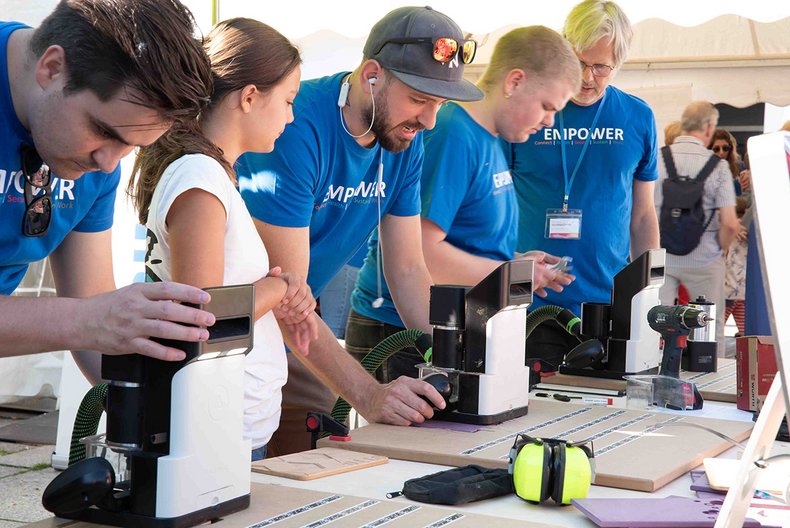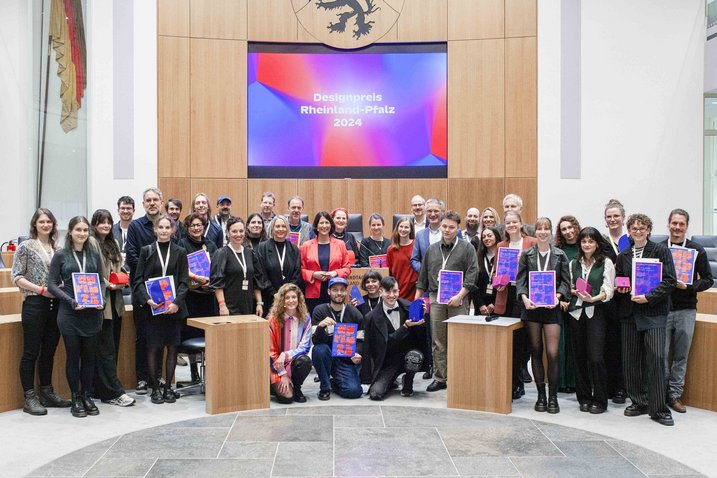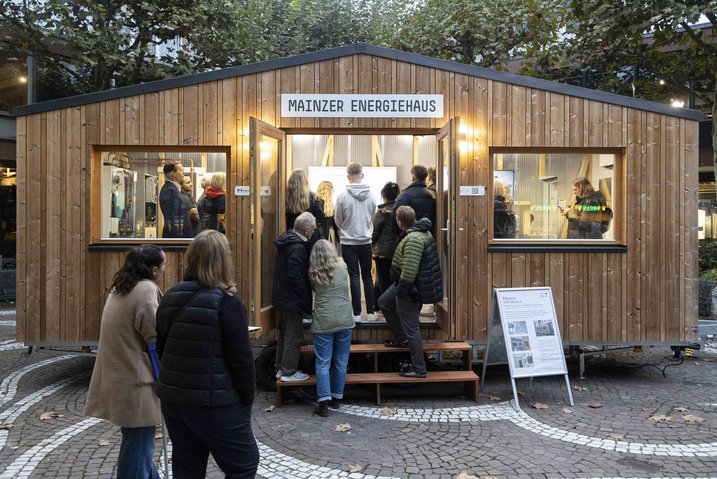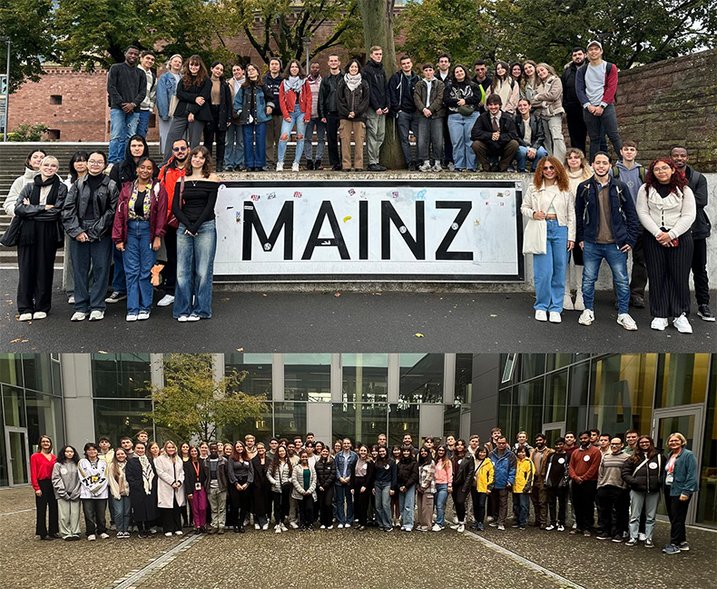Mainz’s Science Fair took place this year on the first weekend in September. Dedicated researchers presented more than 50 research projects in an easy-to-understand way in gloriously sunny weather. Mainz University of Applied Sciences was represented by various projects of the Research Group for Business Informatics and Media Management (WIMM), the Institute for Spatial Information and Surveying Technology (i3mainz), the Institute of Architecture Mainz (AI Mainz), and the cross-university collaborative project EMPOWER. Exciting hands-on activities invited the numerous visitors to be amazed on both days. In addition to the well-established science fair booths, visitors had the opportunity to experience science on stage for the first time.
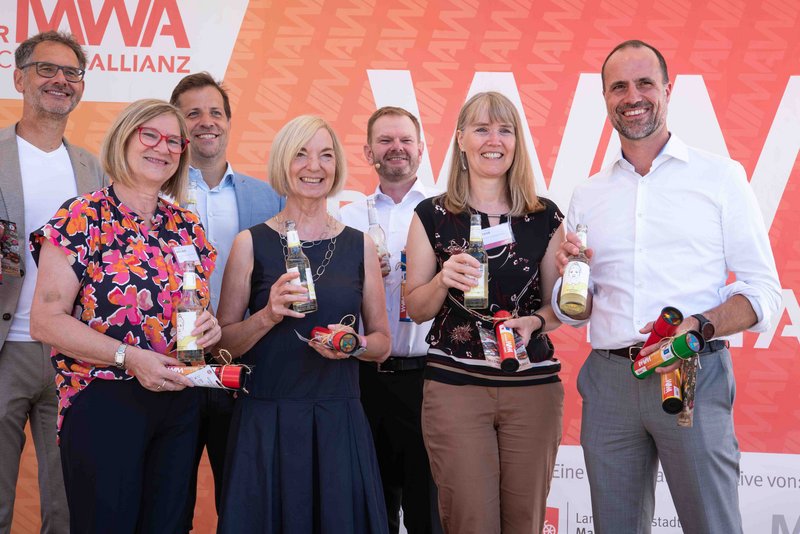
(Photo: Alina Grohe / © Mainz University of Applied Sciences)
After the opening session with (from left) Markus Müller (Director of the State Theater of Mainz), Dr. Sabine Nikolaus (Country Manager Germany Boehringer Ingelheimer), Nino Haase (Mayor of the Capital City of Mainz), Prof. Dr. Susanne Weissman (President of Mainz University of Applied Sciences), Prof. Dr. Michael Maskos (Chairman of the Board of the Mainz Science Alliance), Dr. Birgit Heide (Director of the Mainz State Museum) and Clemens Hoch (Minister of Science and Health of the State of Rhineland-Palatinate), the Chairman of the Mainz Research Alliance encouraged visitors to explore the role of science for people and the community for themselves at the Mainz Science Fair.
There were plenty of opportunities to do so in the tents at Gutenbergplatz and in the LUX Pavilion of Mainz University of Applied Sciences. The projects exhibited in the LUX Pavilion by the Institute of Architecture Mainz invited interested visitors to learn more about ancient temples and medieval wood synagogues using virtual reality goggles and augmented reality apps, as well as to find out more about the Erasmus+ project CovHer.
The collaborative EMPOWER project was represented over the weekend by all five participating universities. In the EMPOWER tent, the previously launched pilot projects on the five sub-projects of Sustainability, Health, Cyber Security, Connectivity and New Work were creatively showcased.
The Connectivity topic, based at Mainz University of Applied Sciences, is about networking through digital infrastructures that fundamentally change the way we live and work. The four projects Digital Manufacturing, Mixed Reality Applications, Smart Industry, and New Venture Studio invited visitors to try out and experience the projects for themselves with well-attended hands-on activities, such as making boards for breakfast or experimenting with virtual reality goggles.
In the Yellow tent, visitors to the booth belonging to the WIMM research group were given a demonstration of the Travelguide web app, which was developed as a prototype in the project bearing the same name by an interdisciplinary research team from the Schools of Business and Engineering at Mainz University of Applied Sciences. As part of the AI4MediaData project presented, interested individuals had the chance to experience eye tracking and facial expression recognition technology live. The aim of the project is to analyze media data using AI methods and to link the information obtained in the form of data-based decision-making support. Another project of the WIMM research group is dedicated to the digital qualification of and for immigrants. Hannah Risser and Janna ten Thoren also presented the research results on Sunday on the stage of the Science Fair.
The absolute highlight for children visiting the Science Fair was the one-on-one interaction with the humanoid robot Pepper, who belongs to the WIMM research group.
At the next tent, the public had the opportunity to try out different methods of 3D data acquisition with cameras at the i3mainz booth and see the differences for themselves.
The Minister of Science and Health, Clemens Hoch, as well as the Mayor of Mainz, Nino Haase, visited the i3mainz booths during their tour of the Science Fair to learn more about the projects of this institute of Mainz University of Applied Sciences, including the project RAFVINIERT–Raumintelligenz für die integrierte Versorgung von Seniorinnen und Senioren in ländlichen Quartieren (RAFVINIERT–Spatial Intelligence for the Integrated Provision of Services for Seniors in Rural Areas), which was also presented on Sunday by project coordinator Florian Brunn in an exchange with moderator Julia Schneider, also from Mainz University of Applied Sciences, on the stage of the Science Fair.
Another highlight of the stage program was the science slam duel of the Network Young Scientists Mainz, moderated by the head of the International Office of Mainz University of Applied Sciences, Gabriel Belinga Belinga, on Saturday evening.
